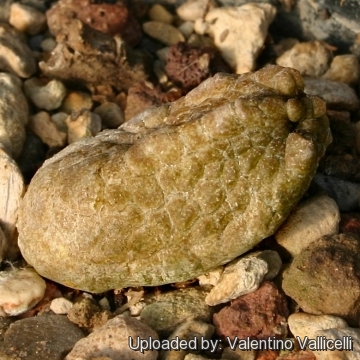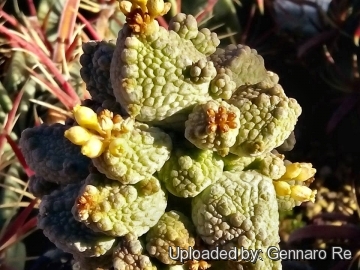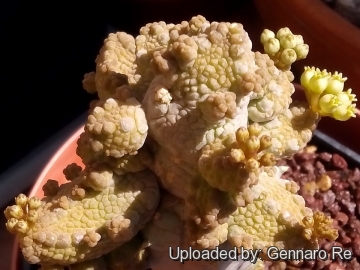
Pseudolithos caput-viperae Photo by: Gennaro Re
Origin and Habitat: Somalia.
Synonyms:
Common Names include:
ENGLISH: Snake Head Pseudolithos, Viper's Head, Head of viper
CHINESE (中文): 蛇頭凝蹄玉
Description: The snake head Pseudolithos (Pseudolithos caput-viperae) is a perennial, small clump-forming stem succulent, single stemmed or sparsely branched, with minute urn-shaped flowers. The stem resembles incredibly like a head of a viper buried in the sand.
Stem: Up to 2 cm high and 1.5-6 cm long (Grafted plant in cultivation may achieve a bigger size) The stem is oval, flattened against the soil with an evident four-sided figure form with rounded angles, and tuberculate, glabrous, recalling the head of a viper lying in the dust. The color may vary from light green (especially for grafted plants in shaded environments) to clear olive/grey or reddish-brown (in full sun).
Roots: Fibrous.
Flower: In small inflorescences on short shoots scattered over the stem. Each inflorescence comprises about 4-30-flowers (usually 20) , with several flowers that open synchronously. The cluster of flowers is fly pollinated and smells like rotten meat.
Bibliography: Major references and further lectures
1) Urs Eggli “Illustrated Handbook of Succulent Plants: Dicotyledons” Springer Science & Business Media, 2002
2) Hermann Jacobsen “A handbook of succulent plants: descriptions, synonyms, and cultural details for succulents other than Cactaceae” Blandford Press, 1960” Timber Press, 18/May/1999
3) Focke Albers, Ulrich Meve “Illustrated Handbook of Succulent Plants: Asclepiadaceae: Asclepiadaceae” Volume 4 Springer Science & Business Media, 2002
 In the northern hemisphere the "head of viper" is often grown grafted, but the fascination of a plant grown on its own roots is Photo by: Valentino Vallicelli
In the northern hemisphere the "head of viper" is often grown grafted, but the fascination of a plant grown on its own roots is Photo by: Valentino Vallicelli In cultivation it needs protection from cold and damp, and requires a 100% mineral substratum. Photo by: Gennaro Re
In cultivation it needs protection from cold and damp, and requires a 100% mineral substratum. Photo by: Gennaro Re Pseudolithos caput-viperae Photo by: Gennaro Re
Pseudolithos caput-viperae Photo by: Gennaro ReSend a photo of this plant.The gallery now contains thousands of pictures, however it is possible to do even more. We are, of course, seeking photos of species not yet shown in the gallery but not only that, we are also looking for better pictures than those already present.
Read More... Cultivation and Propagation: This species, together with Pseudolithos mccoyiSN|12771]]SN|12771]] , is one of the most difficult to keep in cultivation. It is almost invariably grown grafted and is considered very tricky to keep alive on its own roots, because mistakes are costly. If rot sets in, there is practically no time, nor warning, before the plant turns to expensive mush. If we follow the right growing tips it is not so difficult as is commonly supposed, but inaccuracies are fatal. Use 100% mineral soil, don’t bury the base of the plant in the substrate, but place it in a horizontal position on the soil surface. It needs regular watering, especially during the hottest summer days, provide also some light watering in winter if the green house temperatures are elevated. Either excessive and very scarce watering can induce rot.
Frost Tolerance: Winter temperatures must be kept over 10° C. ( But it can withstand a winter night temperature of around 5°, or less for short periods )
Sun Exposure: It takes great advantage if grown in very strong light but sheltered from full sun.
Special cultural practices: Provide very good ventilation. This plant is a candidate for under-potting, as long as you keep it watered.
Propagation: Usually grafted or by seeds that are however seldom available.













